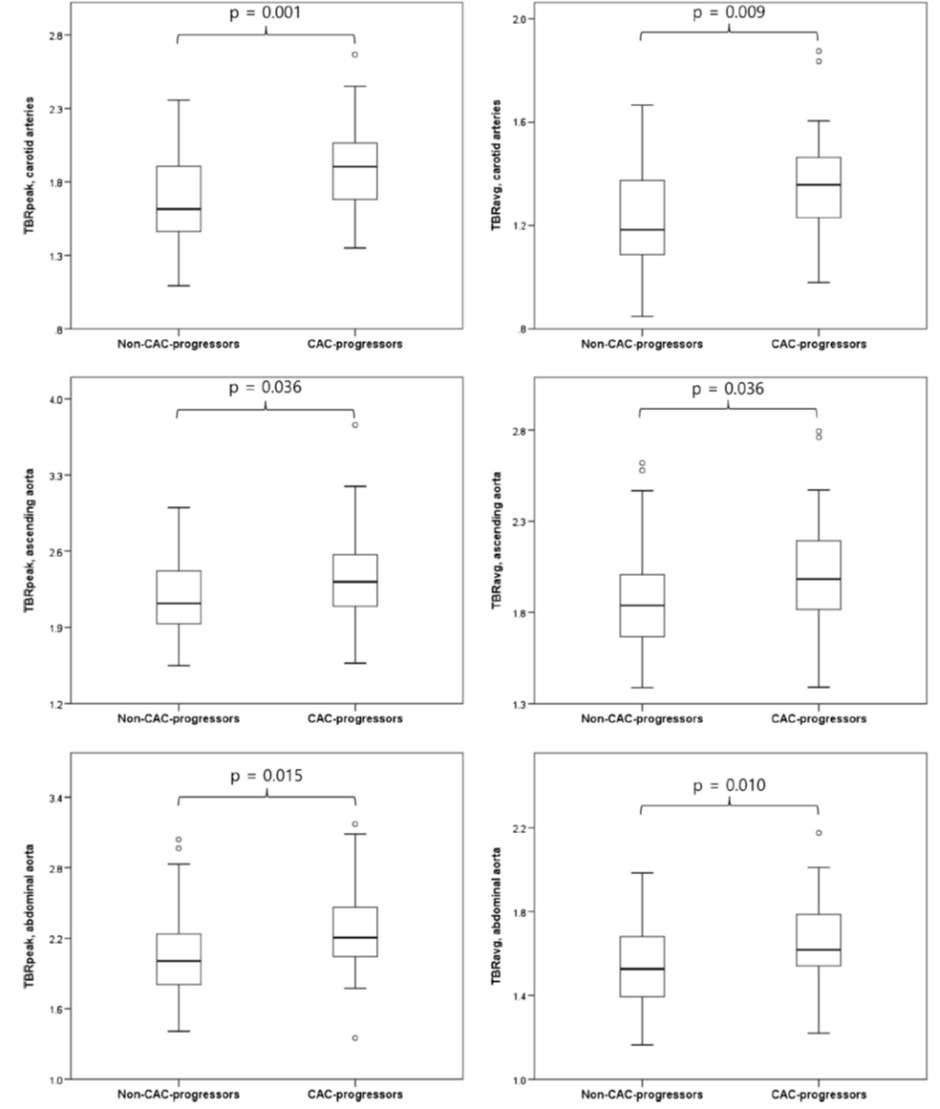글로벌 연구동향
핵의학
![[Eur J Nucl Med Mol Imaging.] Prediction of coronary artery calcium progression by FDG uptake of large arteries in asymptomatic individuals.](/enewspaper/upimages/admin_20170209133850_R.png) 2017년 02월호
2017년 02월호
[Eur J Nucl Med Mol Imaging.] Prediction of coronary artery calcium progression by FDG uptake of large arteries in asymptomatic individuals.전남의대 / 조상건, 범희승*
- 출처
- Eur J Nucl Med Mol Imaging.
- 등재일
- 2017 Jan
- 저널이슈번호
- 44(1):129-140. Epub 2016 Sep 28.
- 내용

그림 1. F-18 FDG PET에서 복부대동맥의 FDG 섭취를 측정하는 과정

그림 2. 관상동맥 칼슘이 증가된 환자들이 그렇지 않은 환자에 비해 높은 혈관 FDG 섭취 정도를 보였으며, 경동맥, 흉부 및 복부대동맥에서 동일하게 나타남.

그림 3. 복부대동맥의 TBRpeak가 2.1 이상인 경우 나이와 무관하게 관상동맥 칼슘 증가를 예측할 수 있었으나(a), 첫 검사에서 이미 관상동맥 칼슘이 있는 환자의 경우 통계적으로 의미 있는 예측은 할 수 없었음(b).

그림 4. 첫 검사에서 관상동맥 칼슘이 없었으나(c), 높은 복부대동맥 FDG 섭취를 보였고(a-b), 3.6년 후 시행된 추적관찰 검사에서 칼슘이 증가한(d, 화살표) 49세 남성의 실제 검사 영상. 칼슘 점수는 0에서 156.4까지 증가함.
Abstract
PURPOSE:The purpose of this study is to evaluate whether fluorodeoxyglucose (FDG) uptake of the large arteries can predict coronary artery calcium (CAC) progression in asymptomatic individuals.METHODS:
Ninety-six asymptomatic individuals who underwent FDG positron emission tomography (PET) and CAC scoring on the same day for health screening and follow-up CAC scoring ≥1 year after baseline studies (mean 4.3 years) were included. Vascular FDG uptake was measured and corrected for blood pool activity to obtain peak and average target-to-blood pool ratios (TBRpeak and TBRavg, respectively) for the carotid arteries, and ascending and abdominal aorta. CAC scores at baseline and follow-up of each individual were measured and absolute CAC change (ΔCAC), annual CAC change (ΔCAC/year), and annual CAC change rate (ΔCAC%/year) were calculated. CAC progression was defined as ΔCAC >0 for individuals with negative baseline CAC; ΔCAC/year ≥10 for those with baseline CAC of 0
RESULTS:
Thirty-one subjects showed CAC progression. CAC-progressors showed significantly higher TBRpeak and TBRavg as compared to non-CAC-progressors for all three arteries. TBRpeak of the abdominal aorta was significantly associated with CAC progression in multivariate analysis, with age and baseline CAC. A higher TBRpeak of the abdominal aorta (≥2.11) was associated with CAC progression among subjects with negative baseline CAC only. In subjects with positive baseline CAC, only the amount of baseline CAC was significantly associated with CAC progression. However, the positive predictive value of the TBRpeak of the abdominal aorta was <40 % when age was <58 or baseline CAC was negative.
CONCLUSIONS:
Higher FDG uptake of the large arteries is associated with an increased risk of CAC progression in asymptomatic subjects with negative baseline CAC. But its clinical application needs further validation.
Author information
Cho SG1, Park KS1, Kim J1, Kang SR2, Kwon SY2, Seon HJ3, Jabin Z2, Kim YJ2, Jeong GC2, Song M2, Song HC1, Min JJ2, Bom HS4.1Department of Nuclear Medicine, Chonnam National University Hospital, 42, Jebong-ro, Dong-gu, Gwang-ju, 61469, Republic of Korea.2Department of Nuclear Medicine, Chonnam National University Hwasun Hospital, 322, Seoyang-ro, Hwasun-eup, Hwasun-gun, Jeollanam-do, 58128, Republic of Korea.3Department of Radiology, Chonnam National University Hwasun Hospital, 322, Seoyang-ro, Hwasun-eup, Hwasun-gun, Jeollanam-do, 58128, Republic of Korea.4Department of Nuclear Medicine, Chonnam National University Hwasun Hospital, 322, Seoyang-ro, Hwasun-eup, Hwasun-gun, Jeollanam-do, 58128, Republic of Korea. hsbom@jnu.ac.kr.
- 키워드
- Atherosclerosis; Coronary artery calcium progression; FDG PET; Vascular uptake
- 연구소개
- 본 연구는 FDG PET을 활용하여 측정된 전신의 혈관 염증 활성도가 관상동맥 칼슘의 증가를 예측할 수 있음을 규명한 연구입니다. 일반적으로 FDG PET 상 혈관의 FDG 섭취가 높게 관찰되는 경우, 해당 부위의 염증 활성도가 높다는 것이 알려져 있습니다. 혈관 염증의 최종 단계로서 관찰되는 것이 칼슘 침착이므로 혈관에 염증이 심하면(즉, FDG 섭취가 높으면) 혈관 칼슘 침착이 빠르게 진행될 것이라 예측할 수 있습니다. 그러나, 관상동맥의 경우 FDG PET 영상을 얻기에 너무 작고, 심장 박동과 주변 심근의 생리학적 FDG 섭취에 의한 제약이 있어 FDG PET을 통해 직접 관상동맥의 염증 활성도를 평가하기란 불가능합니다. 이에 저희는 죽상동맥경화가 전신적인 염증 반응으로 진행되고 그 활성도가 전신의 혈관에서 비슷하게 나타난다는 점에 기존 연구 결과에 착안하였습니다. 그리하여 이번 연구에서는 FDG PET을 통해 영상화가 가능한 목, 흉부, 복부의 큰 동맥의 섭취를 측정하여 관상동맥 칼슘의 증가를 예측할 수 있으리라는 가설을 세웠으며, 연구 결과 전신의 대혈관, 특히 복부대동맥의 FDG 섭취가 높을수록 관상동맥 칼슘의 증가를 독립적으로 예측할 수 있었음을 밝혀냈습니다. 또한, 첫 검사에서 관상동맥 칼슘이 관찰되지 않는 - 기존에 저위험군으로 알려져 있는 - 환자군에서 유의한 예측 능력을 보여줌으로써, 저위험군 환자 중에서도 향후 관상동맥질환의 위험이 높을 수 있는 하위그룹을 추가 발견할 수 있는 근거를 제시하였습니다.
- 덧글달기







